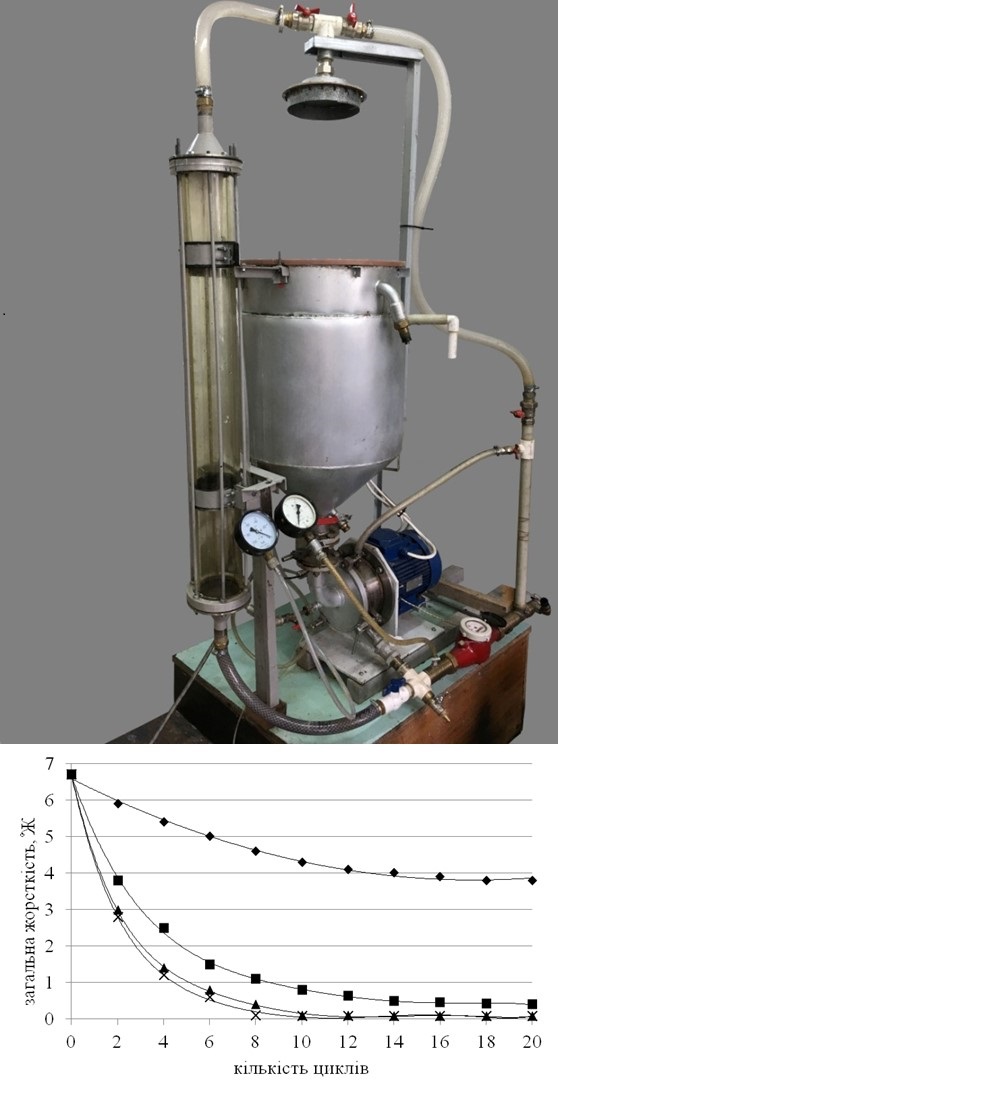Improving the efficiency of calcium hydrocarbonate removal and reducing water hardness through discrete pulse energy input
DOI:
https://doi.org/10.15587/1729-4061.2023.286005Keywords:
total hardness, calcium carbonate, ammonium hydroxide, hydrogen index, shear rateAbstract
For municipal water supply systems, industrial enterprises, and thermal plants, the content of mineral impurities in water is regulated, which necessitates the use of technologies for their removal.
The object of study was water from an artesian well, which was treated on a rotor-pulsation apparatus that implements the principle of discrete-pulse energy input in an aeration-oxidizing setup of rotor type.
The effect of the principle of discrete-pulse energy input on the process of extracting calcium bicarbonate from water to reduce its hardness is studied.
It was determined that when treating water in the rotor-pulsation apparatus without adding ammonium hydroxide solution, it is possible to reduce the calcium ions concentration from 77.1 to 57.1 mg/L, and the total hardness from 13.4 to 7.6 mmol/L. It has been proven that the addition of 0.1 wt.% ammonium hydroxide to the treated water and treatment in the rotor-pulsation apparatus at the flow shear rate of 40·103 s-1 during 10 cycles allows for to reduce in the calcium ions concentration by 99.3 % and to reduce the total hardness to 0.16 mmol/L.
This is explained by the formation of a water-air mixture, which, passing through the rotor-pulsation apparatus, is affected by shock waves, interphase turbulence, microcavitation, and vortices, which leads to an increase in the rate of mass transfer of oxygen from the gas phase to the liquid and its transportation by the liquid. At the same time, the structure of water changes with the formation of free hydrogen bonds, which causes its increased activity and reactive capacity.
Water treatment according to the principle discrete-pulse energy input in the rotor-pulsation apparatus is recommended for use in the implementation of a number of chemical softening methods to reduce the consumption of reagents and increase the degree of purification
References
- Vakkilainen, E. K. (2017). Availability and Reliability. Steam Generation from Biomass, 180–202. doi: https://doi.org/10.1016/b978-0-12-804389-9.00008-3
- Martínez Moya, S., Boluda Botella, N. (2021). Review of Techniques to Reduce and Prevent Carbonate Scale. Prospecting in Water Treatment by Magnetism and Electromagnetism. Water, 13 (17), 2365. doi: https://doi.org/10.3390/w13172365
- Chibowski, E., Szcześ, A. (2018). Magnetic water treatment–A review of the latest approaches. Chemosphere, 203, 54–67. doi: https://doi.org/10.1016/j.chemosphere.2018.03.160
- Mghaiouini, R., Benzbiria, N., Belghiti, M. E., Belghiti, H. E., Monkade, M., El bouari, A. (2020). Optical properties of water under the action of the electromagnetic field in the infrared spectrum. Materials Today: Proceedings, 30, 1046–1051. doi: https://doi.org/10.1016/j.matpr.2020.04.518
- Kukić, D. V., Šćiban, M. B., Mitrović, B. B., Prodanović, J. M., Vasić, V. M., Ivetić, D. Ž., Antov, M. G. (2012). Possibility of improvement of boiler water treatment process—ion exchange vs. reverse osmosis. Desalination and Water Treatment, 51 (1-3), 518–524. doi: https://doi.org/10.1080/19443994.2012.714860
- Brandão, Y. F. F., dos Santos, L. B., de Araújo, G. P., Pedrosa Júnior, L. P., da Costa Neto, B. F., da Silva, R. de C. F. S. et al. (2022). Use of High-Frequency Ultrasound Waves for Boiler Water Demineralization/Desalination Treatment. Energies, 15 (12), 4431. doi: https://doi.org/10.3390/en15124431
- Taqvi, S. A., Sohail, M., Uddin, F. (2016). Utilization of Ion-Exchange Technology for Boiler Feed Water Production-Design and Testing. Chemical Engineering, 1, 26–35. Available at: https://www.researchgate.net/publication/309536721_Utilization_of_Ion-Exchange_Technology_for_Boiler_Feed_Water_Production-Design_and_Testing
- Avdieieva, L. I. (2016). Implementation of the Principle of Discrete-Pulse Energy Input to the Creation of Nanotechnologies for Food Industry. Science and Innovation, 12 (4), 11–15. doi: https://doi.org/10.15407/scine12.04.011
- Dolinskyi, A. A., Obodovych, O. M., Sydorenko, V. V. (2018). Influence of Discrete Pulse Energy Input at Absorption of Oxygen in the Liquid Medium. Journal of Water Chemistry and Technology, 40 (6), 354–358. doi: https://doi.org/10.3103/s1063455x18060073
- Dolinskiy, A. A., Obodovich, A. N., Sydorenko, V. V. (2018). Intensification of aeration and mass transfer in wastewater treatment by discrete-pulse energy input. Thermophysics and Aeromechanics, 25 (4), 623–630. doi: https://doi.org/10.1134/s0869864318040145
- Obodovych, O., Tselen, B., Sydorenko, V., Ivanytskyi, G., Radchenko, N. (2022). Application of the method of discrete-pulse energy input for water degassing in municipal and industrial boilers. Acta Periodica Technologica, 53, 123–130. doi: https://doi.org/10.2298/apt2253123o

Downloads
Published
How to Cite
Issue
Section
License
Copyright (c) 2023 Oleksandr Obodovych, Larysa Sablii, Vitalii Sydorenko, Bogdan Tselen

This work is licensed under a Creative Commons Attribution 4.0 International License.
The consolidation and conditions for the transfer of copyright (identification of authorship) is carried out in the License Agreement. In particular, the authors reserve the right to the authorship of their manuscript and transfer the first publication of this work to the journal under the terms of the Creative Commons CC BY license. At the same time, they have the right to conclude on their own additional agreements concerning the non-exclusive distribution of the work in the form in which it was published by this journal, but provided that the link to the first publication of the article in this journal is preserved.
A license agreement is a document in which the author warrants that he/she owns all copyright for the work (manuscript, article, etc.).
The authors, signing the License Agreement with TECHNOLOGY CENTER PC, have all rights to the further use of their work, provided that they link to our edition in which the work was published.
According to the terms of the License Agreement, the Publisher TECHNOLOGY CENTER PC does not take away your copyrights and receives permission from the authors to use and dissemination of the publication through the world's scientific resources (own electronic resources, scientometric databases, repositories, libraries, etc.).
In the absence of a signed License Agreement or in the absence of this agreement of identifiers allowing to identify the identity of the author, the editors have no right to work with the manuscript.
It is important to remember that there is another type of agreement between authors and publishers – when copyright is transferred from the authors to the publisher. In this case, the authors lose ownership of their work and may not use it in any way.









